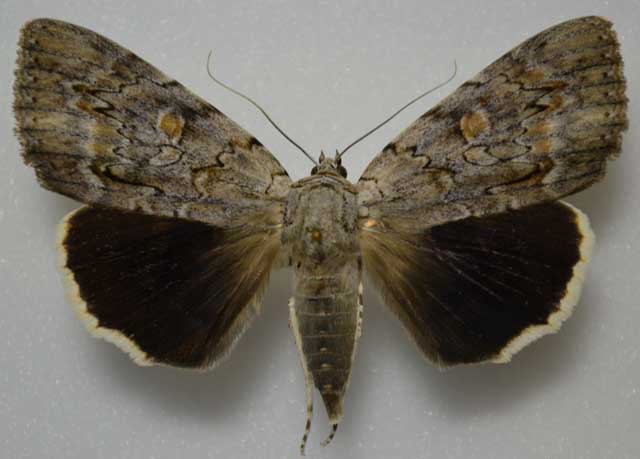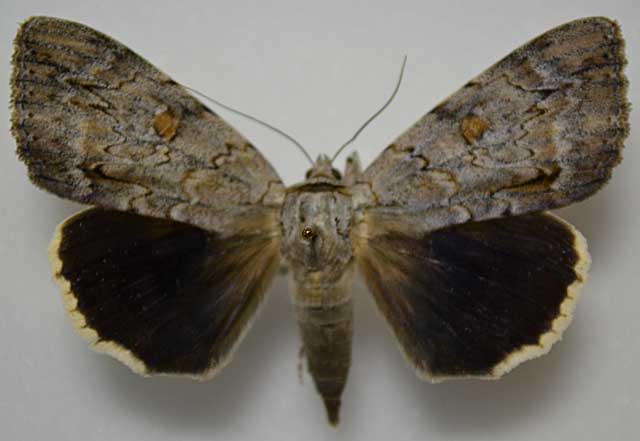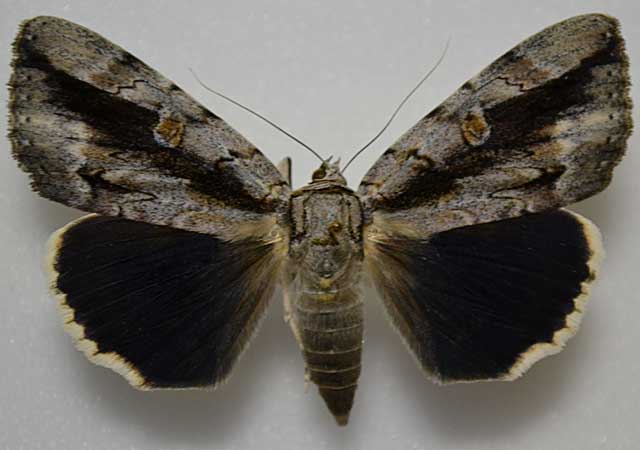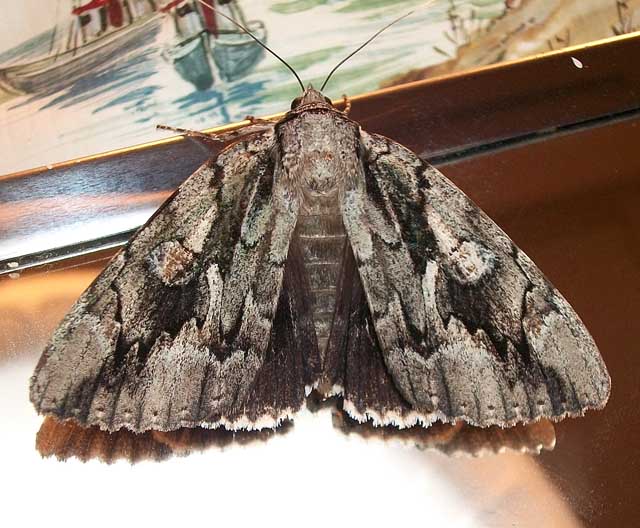Catocala myristica
Catocala myristica
kah-TOCK-uh-lahMmih-rih-STIH-kuh
Hugo L. Kons, Jr. & Robert J. Borth, 2015

Catocala myristica female, Oktibbeha County, Mississippi,
July 8, 2015, courtesy of Ricky Patterson.
This site has been created by Bill Oehlke. Comments, suggestions and/or additional information are welcomed by Bill.
| TAXONOMY:
Superfamily: Noctuoidea
Family: Erebidae, Leach, [1815]
Subfamily: Erebinae, Leach, [1815]
Tribe: Catocalini, Boisduval, [1828]
Genus: Catocala, Schrank, 1802
|
DISTRIBUTION:
Catocala myristica, the Myristica
Underwing, (wingspan: male: 78mm; female: 80mm // forewing length: 33-37mm) flies from
Mississippi: Oktibbeha County and other counties to South Carolina: Berkeley County,
in the Black Belt Ecological Region where it
has been confirmed, and it probably also flies in Georgia (confirmed by James Adams), Alabama, and possibly in
northwestern Florida. Possibly, but less likely, it also flies in Tennessee,
Louisiana,
eastern Texas.
Wikipedia: "Black Belt is still used in the physiographic sense, to describe a crescent-shaped region about 300 miles (480 km) long and up to 25 miles (40 km) wide,
extending from southwest Tennessee to east-central Mississippi and then east through Alabama to the border with Georgia."
Males of this recently described species have at least two forms. One form (male, perhaps also female) has a wide black band running from the outer margin, just
below the apex, to the thorax in the middle of the basal area. The bar widens as it butts against almost the entire outer edge of the reniform spot and then
constricts again somewhat as it continues its course to the body. Remarkably, the bar does not even partially obscure the reniform spot.
In males where there is no bar, the moth is very similar to the slightly larger Catocala robinsonii, but the reniform spot in myristica is noticely more
brown-filled than in robinsonii, and I note that the longest lower lobe of the pm line is dark black and thicker on myristica compared to robinsonii where the
same line is very thin, scarcely noticeable.

Catocala myristica male, Oktibbeha County, Mississippi,
August 1, 2016, courtesy of Ricky Patterson.
In the barred forms of both species, the reniform spot is not encumbered with any of the darker grey scaling of the bar as it is in robinsoni, and robinsoni also
has more dark scaling on the inner edge of the bar.

Catocala myristica barred male, Oktibbeha County, Mississippi,
August 1, 2016, courtesy of Ricky Patterson.
In the significantly smaller flebilis, the dark bar is almost completely broken under the cell, and overall the bar is somewhat reduced in its intensity.

Catocala flebilis, Pickens County, northern Georgia,
65mm, September 17, 2009, courtesy of Aubrey Scott.
Thus far specimens have largely been collected on tree trunks and have not responded to mv or black lights or typical baits.
FLIGHT TIMES AND PREFERRED FOOD PLANTS:
Catocala myristica are usually on the wing in June, July and August.
The Catocala myristica caterpillar probably feeds on nutmeg hickory Carya myristiciformis, and it might be limited to that host. This small tree is
only found in small pockets from northeastern Mexico, eastern Texas, eastern Arkansas to South Carolina on rich moist soils of higher bottom lands and stream banks.
ECLOSION:
Adults eclose from pupae at soil surface.
SCENTING AND MATING:
Catocala myristica females emit an airbourne pheromone and males use their antennae to track the scent plume.
EGGS, CATERPILLARS, COCOONS AND PUPAE:
Eggs are deposited on tree bark in the fall and hatch the following spring.
Larval Food Plants
Listed below are anticipated primary food plant(s) and alternate food plants. It is hoped that this alphabetical listing followed by the common
name of the foodplant will prove useful. The list is not exhaustive, although some species seem very host specific.
Experimenting with closely related foodplants is worthwhile.
Carya myristiciformis .......
|
nutmeg hickory
|
This page is brought to you by Bill Oehlke and the
WLSS. Pages are on space rented from Bizland. If you would like to become a "Patron of the Sphingidae/Catocala Sites",
contact Bill.
Please send sightings/images to Bill. I will do my best to respond to requests for identification help.
Enjoy one of nature's wonderments: Live Saturniidae (Giant Silkmoth) cocoons.

|

To show appreciation for this site, click on the flashing
butterfly to the left, a link
to many worldwide insect sites. |
Return to Canadian Index
Return to Main Catocala Index
Catocala myristica. Number 296 is a female from the type locality collected 8 July 2015.
Number 294 is the black barred male, collected at the type locality on 1 August 2016.
Number 295 is also from the type locality collected 1 August 2016.

Catocala myristica HT male, Oktibbeha County, Mississippi,
78mm, June 27, 2008, on my home computer only.

Catocala myristica male, 78mm, on my home computer only.

Catocala myristica male (barred), 78mm, on my home computer only.

Catocala myristica female, on my home computer only.

Catocala myristica female, 79mm, on my home computer only.

Catocala myristica female (verso), 80mm, on my home computer only.











